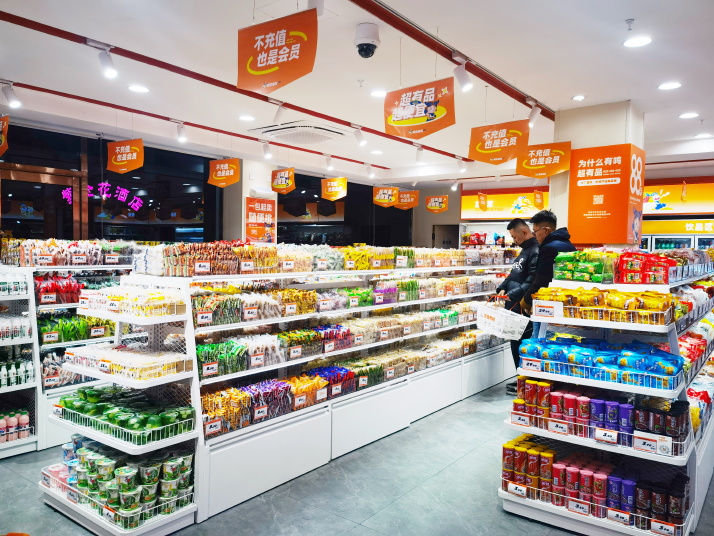
Amid the urban tapestry of many small cities across China, a striking sign commands attention, accompanied by bright window walls that offer a glimpse of neatly arranged shelves. Within, an assortment of snacks in every conceivable color beckons, enticing onlookers to step inside and explore the wonders.
By day, it seamlessly integrates into the rhythm of a local market and the flowing currents of traffic. Yet, as night falls, it emerges as the street’s nocturnal luminary—a beacon of vivid hues and the last to fold its shutters, bestowing the city with a colorful delight at night.
Right now, this is a delight exclusive to residents of small cities.
“A friend of mine who returned from Beijing found these snack shops novel, mentioning she hasn’t seen these kinds of stores there, but there’s one every few blocks here,” 30-year-old Wang Yan, who lives in Baotou, Inner Mongolia Autonomous Region, told Beijing Review. “I even jokingly asked her if she envied me.”
Adjacent to Wang’s residence is a newly opened Yummy Snack store. Wang said the clean and luminous decor of the store, distinct from surrounding establishments, beckons people inside. The selection of snacks is extensive, ranging from renowned brands to unbranded bulk snacks, all with decent quality, and perhaps most importantly, offered at affordable prices. “From my observations, most of the prices are cheaper than those in supermarkets. People seldom leave the stores empty-handed,” Wang said. The experience is akin to online shopping with the joy of instant gratification.
This is the recently burgeoning trend of snack shop chains that have gained popularity in China’s small cities.
According to its official website, Yummy Snack’s first store was established in Chengdu, Sichuan Province, in 2021. As of August 2023, the brand had expanded its presence nationwide, surpassing 2,000 stores. Currently, it is continuing a nationwide expansion strategy at a rate of 200 new stores per month. It aims to open more than 16,000 stores by 2026, covering thousands of counties and small towns.
Yummy Snack is not the only one of its kind. In 2021, snack shop chain Busy For You caught the attention of top-tier investors like HongShan, Gaorong Capital, GenBridge Capital and Maxceed. With a financing of 240 million yuan ($33.6 million), it registered rapid growth and swiftly became a top brand. Starting in Hunan Province, Busy For You was operating over 2,000 stores nationwide by the end of 2022, generating a sales revenue of 6.45 billion yuan ($902.5 million) in the same year.
Affordable delight
What makes these snack shop chains so popular? According to Wen Zhihong, a specialist in the chain-store industry and CEO of Beijing-based consulting firm Hehong Consulting, affordability and professional service are the key factors.
In small cities, the primary venues for snack purchases are supermarkets and individually operated food stores, which are not as professional as chain stores in terms of scale, variety of products, and in-store ambiance. And it’s hard for them to offer prices lower than those in chain stores, Wen told Beijing Review.
Their ability to maintain such low prices is primarily attributable to their large-scale procurement, refined management and brand influence, said Pan Jun, a global product strategy advisor with Bain & Co. management consultancy.
Through large-scale procurement strategies, the chain stores can not only collaborate directly with large suppliers, reducing intermediary steps, but also gain greater bargaining power, thereby lowering costs. By utilizing automated equipment, it’s possible to reduce labor and operational costs. Establishing a distinctive brand image and reputation enables them to draw in more consumers, ultimately boosting sales to compensate for low profit margins, Pan told Beijing Review.
Wen added that a higher degree of leisureliness in small cities also contributes to the popularity. He said people in small cities have more time to go shopping offline. Moreover, the limited presence and low penetration of nationally popular snack brands, such as Three Squirrels and Bestore, in small cities provides opportunities for those chain stores as well.
The involvement of capital has also made snack shop chains a sought-after business. There is a gradual awareness of the market potential within the snack industry. According to iiMedia Research, the market scale of China’s snack industry is continuing to grow, reaching 1.17 trillion yuan ($162.9 billion) in 2022. It is expected to reach 1.24 trillion yuan ($173.1 billion) by 2027. Meanwhile, China’s per-capita snack consumption is approximately one third of Japan’s and one sixth of the United States’, indicating vast potential for development.
Consequently, as more players rapidly enter the scene, these chain stores are undergoing a phenomenal expansion in small cities throughout China. According to Huatai Securities, as of June, the total number of these snack shop chains nationwide had exceeded 16,000, showing an annual growth rate of over 100 percent in both 2021 and 2022.

Aiming big?
The rapid expansion of these snack stores reminds people of Mixue Bingcheng, a Chinese chain of stores selling fresh ice cream and tea.
Despite its affordable pricing and focus on the lower-end markets, Mixue Bingcheng not only competes effortlessly with other premium tea shops but has also expanded its storefronts across China’s regions and into international markets.
In terms of the number of stores, Mixue Bingcheng has already become the world’s fifth largest chain store, alongside the likes of McDonald’s, Subway, Starbucks and KFC. It’s reported that its annual revenue in the overseas market exceeded 1 billion yuan ($139.8 million) in 2022.
Employing a similar strategy of budget-friendly pricing and a concentration on lower-end markets, the snack shop chains are referred to as the “Mixue Bingcheng” of the snack world.
In recent years, there has been a growing focus on China’s lower-end markets. From domestic
e-commerce platform Pinduoduo to the international retail giant Starbucks, all eyes are on tapping into the vast opportunities presented by these emerging markets. In its recently disclosed 2025 strategic vision, the Starbucks China headquarters explicitly stated that their focus will extend beyond the 300-plus city-level markets to include nearly 3,000 county-level markets.
With less competition pressure, and lower rents and staff costs, entrepreneurs have more room for development in the lower-end markets. Crucially, lower-end markets are characterized by substantial populations, pointing to immense market potential that remains largely untapped, Pan said.
“With the advancement of economic development and urbanization, the ascent of lower-end markets is inevitable,” he said.
But whether these snack stores can seize the opportunities in the lower-end market and become another Mixue Bingcheng remains to be observed. Wen expressed his optimism about the prospects of the snack shop chains, highlighting that their high cost-effectiveness inherently aligns with the fundamental logic of development in the retail sector. The essence behind the evolution and iteration of the retail industry is, in fact, an ongoing pursuit of high cost-effectiveness.
Pan said despite opportunities such as huge market potential, increasing consumer demand and low operation costs, the stores also face challenges like more competition, insufficient consumer purchasing power, and product homogeneity.
They need to focus on differentiated management, improve product quality and strengthen brand building, he suggested. –The Daily Mail-Beijing Review news exchange item





